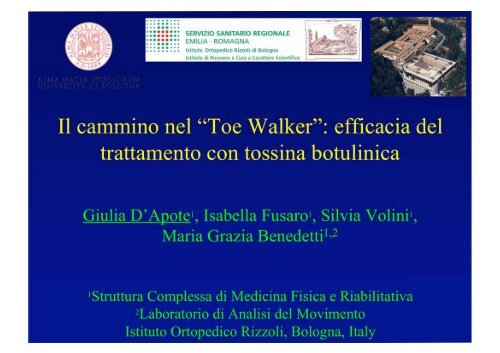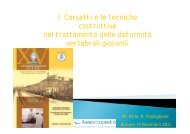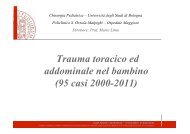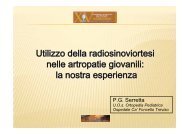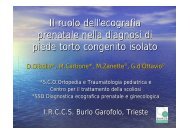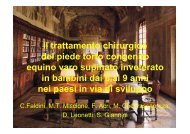toe-walking idiopatico - CSR Congressi srl
toe-walking idiopatico - CSR Congressi srl
toe-walking idiopatico - CSR Congressi srl
Create successful ePaper yourself
Turn your PDF publications into a flip-book with our unique Google optimized e-Paper software.
Il cammino nel “Toe Walker”: efficacia del<br />
trattamento con tossina botulinica<br />
Giulia D’Apote 1, Isabella Fusaro 1, Silvia Volini 1,<br />
Maria Grazia Benedetti 1,2<br />
1Struttura Complessa di Medicina Fisica e Riabilitativa<br />
2 Laboratorio di Analisi del Movimento<br />
Istituto Ortopedico Rizzoli, Bologna, Italy
TOE-WALKING IDIOPATICO<br />
Condizione che si osserva tipicamente nell’età infantile, caratterizzata da<br />
pattern di cammino abituale sulle punte in assenza di causa nota.<br />
Oltre i due anni di età, la diagnosi è di esclusione:<br />
Paralisi Cerebrale Infantile o forme familiari<br />
malattie neuromuscolari o disrafismi<br />
patologie ortopediche<br />
disturbi comportamentali come autismo, disordini comunicativi, disturbi<br />
dell’apprendimento
CONSEGUENZE A LUNGO<br />
CONSERVATIVO<br />
• Uso di tutori<br />
• Stretching<br />
TERMINE<br />
• Sviluppo di piede equino strutturato<br />
• Sovraccarico lombare<br />
• Sviluppo di patologie del rachide<br />
TRATTAMENTO<br />
Hirsch G, Wagner B. The natural history of<br />
idiopathic <strong>toe</strong> – <strong>walking</strong> : a long term follow –<br />
up of fourteen conservatively treated children.<br />
Acta paediatr. 2004 Feb; 93(2):196-9.<br />
Taussig G, Delouvée E. Idiopathic <strong>toe</strong> walker<br />
child. Diagnosis and spontaneous evolution.<br />
Ann Readapt Med Phys. 2001 Jul;44(6):333-9.<br />
NON CONSERVATIVO<br />
• Allungamento chirurgico del<br />
Tendine di Achille
SCOPO DELLO STUDIO<br />
Valutare l’efficacia della Tossina Botulinica<br />
nel trattamento del piede equino<br />
nel bambino “Toe-walker” <strong>idiopatico</strong><br />
Il razionale all’uso della tossina<br />
in tali pazienti è basato sul<br />
rilassamento muscolare del<br />
gastrocnemio ottenuto in<br />
seguito alla somministrazione,<br />
quindi sulla possibilità di<br />
ripristinare un corretto appoggio<br />
del tallone al suolo durante la<br />
deambulazione
LETTERATURA<br />
Gormley M, Herring G,Gaebler-Spira. The use of botulinum toxin in children: a<br />
retrospective study of adverse reactions and treatment of idiopathic <strong>toe</strong>-<strong>walking</strong>. Eur<br />
Jour Neurol. 1997; 4(suppl 2):S27-30.<br />
Brunt D, Woo R, Kim HD, Ko MS, Senesac C, Li S. Effect of botulinum toxin type A<br />
on gait of children who are idiopathic <strong>toe</strong>-walkers. J Surg Orthop Adv. 2004<br />
Fall;13(3):149-55.<br />
Jacks LK, Michels DM, Smith BP, Koman LA, Shilt J. Clinical usefulness of<br />
botulinum toxin in the lower extremity. Foot Ankle Clin. 2004 Jun;9(2):339-48.<br />
Fehlings D. The use of botulinum toxin in paediatric hypertonia. Paediatr Child<br />
Health. 2005 Sep;10(7):379-81.<br />
LIMITI<br />
• Scarsa<br />
• Casistica poco numerosa<br />
• Condizioni non omogenee di <strong>toe</strong> <strong>walking</strong> (includono anche<br />
casi di PCI)<br />
• Studi retrospettivi
LETTERATURA<br />
C’è accordo sulla necessità di individuare una terapia<br />
efficace in alternativa a quella esclusivamente<br />
conservativa o a quella chirurgica per evitare le<br />
complicanze a lungo termine legate a tale condizione<br />
Assenza del primo rotolamento e precoce<br />
sollevamento del tallone - cinematica<br />
Assenza del primo rotolamento e precoce<br />
sollevamento del tallone - cinetica
DISEGNO DELLO STUDIO<br />
STUDIO CROSS OVER<br />
Controllato e Randomizzato<br />
15 Bambini “Toe walkers BTX” 15 Bambini “ Toe walkers Controllo”<br />
Diagnosi effettuata con valutazione multispecialistica = neuropsichiatra infantile,<br />
fisiatra, ortopedico, RMN, ecografia del tendine di Achille<br />
Potenza del campione con miglioramento atteso per la dorsiflessione di 5 gradi<br />
Valutazione clinica: dorsiflessione TT, angolo popliteo<br />
Valutazione strumentale : Gait Analysis<br />
Pre-trattamento, post 1 mese , post 3 mesi, post 6 mesi<br />
STUDIO PILOTA su “Toe walkers BTX”<br />
9 bambini (età compresa tra 4-10 anni, tutti maschi)<br />
pre trattamento controllati a 1 mese, 5 controllati a tre mesi
VALUTAZIONE CLINICA<br />
Misurazione della dorsiflessione della TT a<br />
ginocchio esteso<br />
Angolo popliteo
GAIT ANALYSIS<br />
Laboratorio di Analisi del Movimento<br />
Istituto Ortopedico Rizzoli<br />
TEMPO 0 : PRE-TRATTAMENTO<br />
TEMPO 1 : POST 1 MESE (9 pz)<br />
TEMPO 2: POST 3 MESI (5 pz)<br />
TEMPO 3: POST 6 MESI
Gait Analysis (Istituto Ortopedico Rizzoli, Prof. Sandro Giannini)<br />
80<br />
Flex<br />
deg<br />
Ext<br />
-20<br />
Dinamometria<br />
Piattaforme dinamometriche<br />
Kistler<br />
Knee Flexion/Extension<br />
CINEMATICA<br />
(rotazioni segmentali<br />
e articolari)<br />
153<br />
Up<br />
%<br />
Dw<br />
-52<br />
Vertical Force<br />
FORZA<br />
(reazione<br />
piede-suolo)<br />
Stereofotogrammetria<br />
Telecamere a infrarossi (VICON)<br />
800<br />
Gen<br />
W<br />
Abs<br />
-400<br />
Sagittal Ankle Power*<br />
CINETICA<br />
(momenti e potenze<br />
articolari)<br />
16<br />
mV<br />
-16<br />
10<br />
mV<br />
-6<br />
EMG dinamica di superficie<br />
Elettrodi su muscoli-chiave<br />
Sistema Zero-wire<br />
R_TA<br />
L_RF<br />
ELETTROMIOGRAFIA<br />
(attivazione muscolare)
TERAPIA CON TOSSINA BOTULINICA<br />
(Botox)<br />
PAZIENTE SESSO ETA’ D O S E SEDE<br />
C. F. M 4 anni<br />
INOCULATA<br />
TOTALE 200 unità G e m e l l i<br />
bilateralmente<br />
D. M. M 9 anni 400 unità G e m e l l i<br />
bilateralmente<br />
D. I. M 6 anni 300 unità G e m e l l i<br />
bilateralmente<br />
F. D. M 8 anni 300 unità G e m e l l i<br />
bilateralmente<br />
M. E. M 10 anni 400 unità G e m e l l i<br />
bilateralmente<br />
M. L. M 7 anni 400 unità G e m e l l i<br />
bilateralmente<br />
R. V. M 8 anni 400 unità G e m e l l i<br />
bilateralmente<br />
S. G. M 10 anni 400 unità G e m e l l i<br />
bilateralmente<br />
V. G. M 7 anni 400 unità G e m e l l i<br />
bilateralmente<br />
9 bambini<br />
Età media: 7,6 aa<br />
(range 4-10 aa)<br />
tutti maschi<br />
DOSE<br />
INOCULATA:<br />
Fino a<br />
6U/KG/MUSCOLO
La terapia è stata integrata dall’utilizzo di tutori AFO<br />
durante il giorno per almeno 3 mesi e da un<br />
programma di stretching ed esercizi per il controllo<br />
dello schema del passo
ANALISI DEI DATI<br />
I dati relativi ai parametri spazio-temporali e alla<br />
cinematica di pelvi, anca, ginocchio e tibio-tarsica<br />
sono stati statisticamente analizzati con il metodo<br />
GLM con valori pre-post trattamento come effetto<br />
fisso e pazienti come effetto random, accettando una<br />
significatività di p
Clinicamente i valori medi di dorsiflessione pre trattamento di 0° sono<br />
passati a valori medi di dorsiflessione post trattamento di 5°<br />
NOME Dorsiflessione TIBIO-TARSICA (GRADI)<br />
P R E<br />
DX<br />
P R E<br />
SIN<br />
POST<br />
1 DX<br />
POST<br />
1 SIN<br />
POST<br />
2 DX<br />
POST<br />
2 SIN<br />
C. F. 0 0 10 10 10 10<br />
D. M. 0 -5 0 0 5 5<br />
D. I. 0 0 5 5 0 0<br />
F. D. 0 0 5 5 0 0<br />
M. E. 0 0 5 5 10 10<br />
M. L. 5 5 10 10 5 5<br />
R. V. 0 0 5 5 10 15<br />
S. G. 0 0 5 5 5 0<br />
V. G. -5 -5 0 0 10 10<br />
MEDIA 0 -0,5 5 5 5 5<br />
DEVIAZIONE<br />
STANDARD<br />
RISULTATI<br />
2,35 2,83 3,33 3,33 5,77 5,47<br />
Non sono state evidenziate differenze statistiche per l’angolo popliteo
RISULTATI GAIT ANALYSIS<br />
PARAMETRI SPAZIO-TEMPORALI<br />
PRE-trattamento<br />
(9 soggetti)<br />
POST-Trattamento 1<br />
mese (9 soggetti)<br />
GLM<br />
analysis<br />
POSt-Trattamento 3<br />
mesi (5 soggetti)<br />
GLM con paziente effetto<br />
random e pre, post1 e<br />
post2 effetto fisso<br />
Media DS Media DS p Media DS p<br />
L Stance Time (% Stride) 58,16 2,01 57,84 2,25 ns 58,37 1,82 ns<br />
R Stance Time (% Stride) 58,19 2,10 58,93 2,82 ns 58,27 1,71 ns<br />
L Swing Time (% Stride) 41,84 2,01 42,16 2,25 ns 41,63 1,82 ns<br />
R Swing Time (% Stride) 41,81 2,10 41,07 2,82 ns 41,73 1,71 ns<br />
L Stride Length (cm) 101,94 15,18 97,56 14,72 ns 101,14 16,57 ns<br />
R Stride Length (cm) 101,90 15,16 97,22 14,59 ns 101,05 15,61 ns<br />
L Stride Length Normalis ed (%h) 79,85 10,00 75,62 10,70 ns 77,34 6,69 ns<br />
R Stride Length Normalis ed (%h) 79,73 9,30 75,44 11,36 ns 77,42 6,92 ns<br />
L Cycle Time (s ) 0,90 0,09 0,97 0,13 0.02 0,93 0,10 ns<br />
R Cycle Time (s ) 0,91 0,09 0,97 0,11 0.04 0,93 0,08 ns<br />
L Cadence (s tride/min) 67,21 6,59 62,97 8,76 0.05 65,37 8,11 ns<br />
R Cadence (s tride/min) 66,77 6,95 63,01 7,86 ns 65,11 6,22 ns<br />
L Speed (cm/s ) 114,12 20,03 102,21 20,03 0.03 110,10 22,17 ns<br />
R Speed (cm/s ) 113,27 19,69 101,77 18,31 0.03 109,60 19,56 ns<br />
L Speed Normalis ed (%h/s ) 89,65 15,56 79,61 16,54 0.02 84,47 14,60 ns<br />
R Speed normalis ed (%h/s ) 88,99 15,29 79,23 15,21 0.02 84,19 12,70 ns<br />
Diminuzione della velocità del cammino ad 1 mese e relativo incremento della<br />
durata del passo<br />
Normalizzazione a 3 mesi
RISULTATI GAIT ANALYSIS<br />
Pretrattamento<br />
caso 1<br />
Post<br />
1 mese<br />
Post<br />
3 mesi
RISULTATI GAIT ANALYSIS<br />
Pretrattamento<br />
caso 2<br />
Post<br />
1 mese<br />
Post<br />
3 mesi
ROTAZIONI PELVICHE<br />
PRE-trattamento<br />
(9 soggetti)<br />
POST-Trattamento 1<br />
mese (9 soggetti)<br />
GLM<br />
analysis<br />
POSt-Trattamento 3<br />
mesi (5 soggetti)<br />
GLM con paziente effetto<br />
random e pre, post1 e<br />
post2 effetto fisso<br />
(DEG) Media DS Media DS p Media DS p<br />
Pelvis L M ax rotation - s ag. plane 16,74 5,20 16,18 3,64 ns 11,49 3,51
CINEMATICA ANCA<br />
PRE-trattamento POST-Trattamento 1<br />
(9 soggetti) mese (9 soggetti)<br />
GLM<br />
analysis<br />
POSt-Trattamento 3<br />
mesi (5 soggetti)<br />
GLM con paziente effetto<br />
random e pre, post1 e<br />
post2 effetto fisso<br />
(DEG) Media DS Media DS p Media DS p<br />
Hip L Flexion at Foot Contact 32,02 6,19 30,87 6,17 ns 26,48 3,64 0.003<br />
Hip R Flexion at Foot Contact 31,96 5,13 31,86 7,54 ns 27,54 3,10 ns<br />
Hip L M ax extention in Stance -7,42 4,90 -4,95 6,07 ns -8,92 4,12 ns<br />
Hip R M ax extention in Stance -5,15 4,38 -4,28 5,60 ns -8,59 4,54 ns<br />
Hip L Flexion at Toe Off -2,32 5,80 0,26 6,03 ns -2,85 4,63 ns<br />
Hip R Flexion at Toe Off -0,69 4,73 0,15 5,82 ns -3,23 5,55 ns<br />
Hip L M ax flexion in Swing 38,54 5,79 38,40 6,46 ns 35,06 4,82 ns<br />
Hip R M ax flexion in Swing 38,46 4,42 37,49 6,38 ns 34,39 4,29 ns<br />
Hip L ROM - s ag. plane 45,96 7,55 43,52 9,63 ns 43,98 7,13 ns<br />
Hip R ROM - s ag. plane 43,80 6,59 42,12 8,62 ns 43,12 7,06 ns<br />
Hip L ROM - cor. plane 15,84 3,10 16,35 3,30 ns 14,66 2,88 ns<br />
Hip R ROM - cor. plane 15,34 3,36 16,57 3,83 ns 15,49 3,26 ns<br />
Hip L M ax adduction in Stance 5,78 2,13 5,23 3,80 ns 8,14 3,11 0.001<br />
Hip R M ax adduction in Stance 7,88 2,71 8,48 3,96 ns 7,43 2,22 ns<br />
Hip L M ax A bduction in Swing -9,90 3,56 -11,01 4,46 ns -6,52 2,30
CINEMATICA GINOCCHIO<br />
PRE-trattamento<br />
(9 soggetti)<br />
POST-Trattamento 1<br />
mese (9 soggetti)<br />
GDM<br />
analysis<br />
POSt-Trattamento 3<br />
mesi (5 soggetti)<br />
GLM con paziente effetto<br />
random e pre, post1 e<br />
post2 effetto fisso<br />
(DEG) Media DS Media DS p Media DS p<br />
Knee L Flexion at Foot Contact 5,84 5,77 5,17 5,02 ns 4,37 5,87 ns<br />
Knee R Flexion at Foot Contact 7,58 5,43 7,10 6,07 ns 7,68 5,89 ns<br />
Knee L M ax flexion at loading res pons e 18,72 7,83 17,87 8,18 ns 12,52 8,26 ns<br />
Knee R M ax flexion at loading res pons e 21,28 7,38 18,25 8,40 ns 17,22 7,51 ns<br />
Knee L M ax extention in Stance 4,82 6,71 5,92 5,48 ns 2,42 4,50 ns<br />
Knee R M ax extention in Stance 8,37 7,86 6,92 6,19 ns 5,78 6,38 ns<br />
Knee L Flexion at Toe Off 32,57 6,99 34,50 6,62 ns 34,62 5,71 ns<br />
Knee R Flexion at Toe Off 34,62 7,39 35,17 6,75 ns 38,32 9,75 ns<br />
Knee L M ax flexion in Swing 63,91 7,79 65,37 8,15 ns 66,89 4,35 ns<br />
Knee R M ax flexion in Swing 66,78 5,67 64,99 9,87 ns 68,18 8,63 ns<br />
Knee L ROM - s ag. plane 63,36 7,27 64,21 7,59 ns 67,14 3,56 ns<br />
Knee R ROM - s ag. plane 62,75 5,54 61,53 9,43 ns 64,08 8,60 ns<br />
Ridotta flessione nella fase<br />
di risposta al carico<br />
(dati non statisticamente<br />
significativi)<br />
Bambini<br />
normali<br />
Toewalkers
CINEMATICA TIBIO-TARSICA<br />
PRE-trattamento POST-Trattamento 1 GLM POSt-Trattamento 3 GLM con paziente effetto<br />
(9 soggetti) mese (9 soggetti) analysis mesi (5 soggetti) random e pre, post1 e<br />
post2 effetto fisso<br />
(DEG) Media DS Media DS p Media DS p<br />
A nkle L Flexion at Foot Contact -9,19 6,36 -8,75 5,99 ns -9,74 5,40 ns<br />
A nkle R Flexion at Foot Contact -7,37 6,99 -6,68 6,45 ns -6,78 5,27 ns<br />
Ankle L Max plantar-flex at loading response -9,66 5,97 -9,62 6,01 ns -11,42 4,28 ns<br />
Ankle R Max plantar-flex at loading response -8,24 6,43 -7,84 5,76 ns -7,76 4,72 ns<br />
A nkle L M ax dors i-flex in Stance 8,10 6,85 6,55 7,84 ns 6,16 6,83 ns<br />
A nkle R M ax dors i-flex in Stance 8,80 6,75 7,92 6,10 ns 9,78 4,79 ns<br />
A nkle L Plantar-flex at Toe Off -18,83 9,17 -15,41 7,92 ns -15,15 8,62 ns<br />
A nkle R Plantar-flex at Toe Off -17,72 8,49 -15,84 9,20 ns -12,97 8,90 ns<br />
A nkle L M ax plantar-flex in Swing -22,66 8,09 -18,58 8,04 ns -18,63 7,79 ns<br />
A nkle R M ax plantar-flex in Swing -20,78 7,84 -18,82 9,56 ns -16,01 8,84 ns<br />
A nkle L ROM - s ag. plane 30,98 5,32 25,23 4,11
Pretrattamento<br />
RISULTATI – EMG<br />
Post<br />
1 mese<br />
Post<br />
3 mesi
CONCLUSIONI<br />
L’elaborazione statistica ha dimostrato che dopo 1 mese dalla<br />
somministrazione della tossina non si sono osservate differenze nel<br />
cammino attraverso la Gait Analysis<br />
Questo contrasta con quanto osservato clinicamente (miglioramento<br />
dei valori medi di dorsiflessione di 5° ) ma potrebbe essere attribuito al<br />
fatto che il bambino, in seguito alla terapia, abbia bisogno di un tempo<br />
maggiore per riorganizzare il proprio schema del passo<br />
I risultati a 3 mesi evidenziano invece un miglioramento dei parametri<br />
della cinematica, con un più corretto schema di appoggio e con una<br />
minore tendenza allo sviluppo di compensi
CONCLUSIONI<br />
Pur essendo uno studio pilota si può affermare che la Tossina<br />
Botulinica rappresenta una terapia valida ed efficace nel trattamento del<br />
<strong>toe</strong>-<strong>walking</strong> <strong>idiopatico</strong><br />
Può essere considerata un trattamento preventivo per lo sviluppo di<br />
retrazione dell’Achille e di sovraccarico lombare nei casi che non<br />
rispondono ad altre terapie conservative o che non regrediscono<br />
spontaneamente, procrastinando o evitando il ricorso alla chirurgia<br />
Per convalidare i risultati ottenuti con lo studio pilota, basandoci su<br />
questi dati incoraggianti, proseguiremo con lo studio cross-over.
Inaugurazione<br />
Istituti Ortopedici Rizzoli<br />
28 giugno 1896<br />
GRAZIE


